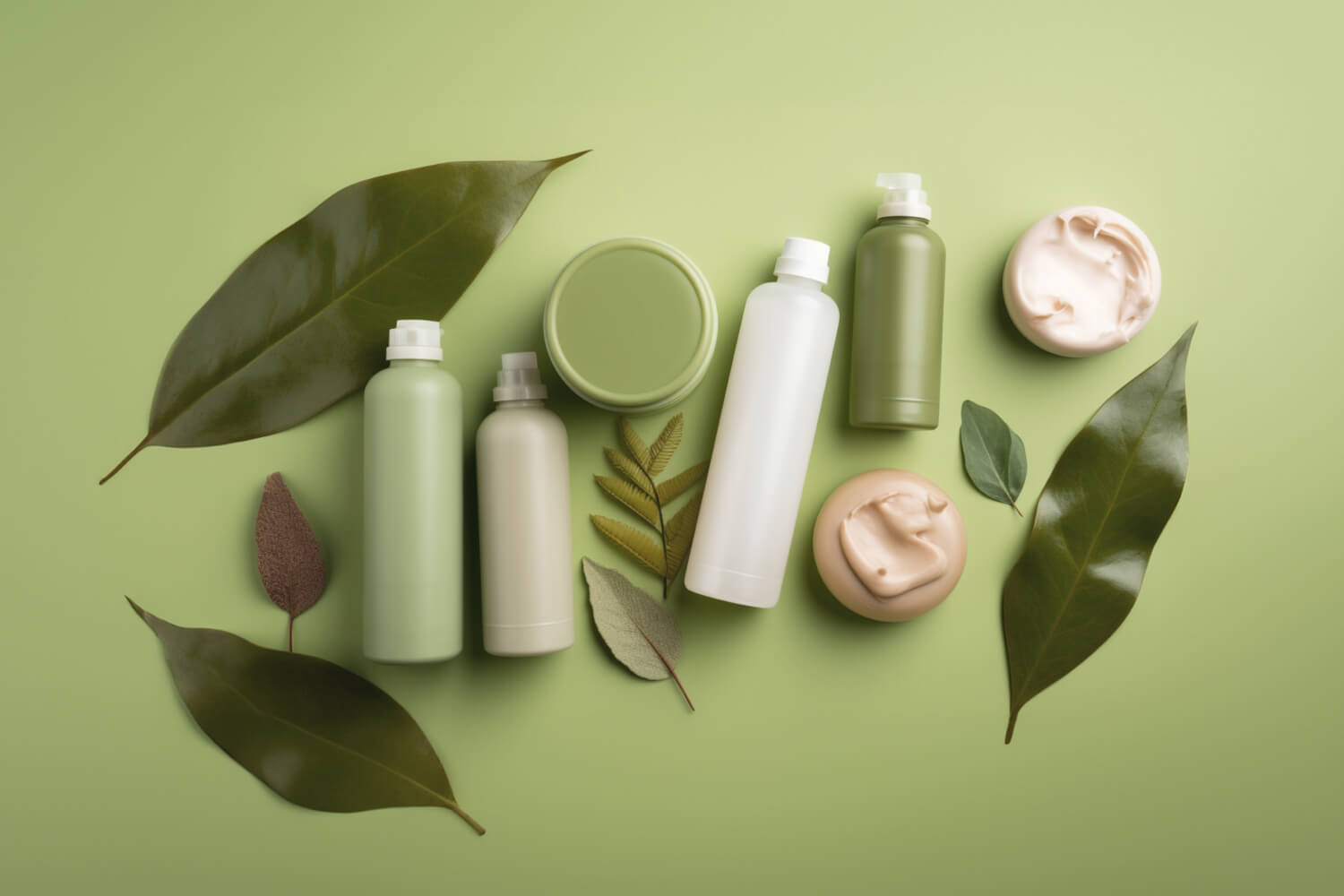
If you’re up to date with the world of beauty, you’ve surely come across many brands claiming they use one sustainable key ingredient in their formulas. But is one key ingredient enough to make a formula sustainable? What are the most sustainable ingredients in cosmetics? And what does it mean for an ingredient to be sustainable? Do these claims stand up to scrutiny or are they just marketing claims, also known as greenwashing? To help you navigate the world of sustainable ingredients, we’re taking a deep dive into these questions.
On this post:
- How much do ingredients count for the overall sustainability of cosmetics?
- What are sustainable ingredients in cosmetics?
- What are the least sustainable ingredients?
- What are the most sustainable cosmetic ingredients?
- Are organic and natural ingredients more sustainable than synthetic?
How much do ingredients count for the overall sustainability of cosmetics?
Ok, so you want to identify a sustainable cosmetic product. How much do the ingredients matter in this? Well, research suggests that around 16% of the sustainability impact of a product comes from the ingredients that go into the formula. That’s roughly 1/6 of the a product’s entire sustainability impact!
Ingredients aren’t the only issue worth taking into consideration, of course–there’s an entire list of sustainability impacts of a cosmetic–, but they’re definitely impactful and should be considered. Sourcing the right ingredients can help reduce a product’s environmental impact!
What are sustainable ingredients in cosmetics?
We’ve already concluded that sourcing sustainable ingredients is a key step for a cosmetic to be sustainable. But what are sustainable cosmetic ingredients? There are five things we must consider when evaluating how sustainable an ingredient is:
- Composition. What does the ingredient contain, and what can it form during its processing life?
- How the ingredient is extracted, purified, and/or synthesized;
- The source of the ingredient: animal-derived, botanical, or microbial. Is the ingredient synthesized or naturally derived?
- Biodegradability. Is the ingredient biodegradable, and if so in what conditions?
- Social impact. What are the social impacts of obtaining and using the raw materials that form the basis of this ingredient? Does the supply chain pay living wages, do companies use unpaid workers, are there Fair Trade agreements?
This is why it’s so hard to classify ingredients using a binary system of sustainable/not sustainable. Ingredients may be more or less sustainable according to different aspects of this analysis, but we should not think of the idea of “sustainable ingredients” as a closed concept. A perfectly sustainable ingredient is almost impossible to find, but increasingly sustainable ingredients contribute to increasingly sustainable formulas as a whole. In the end, the ideal is for the finished product to be the most sustainable it can be.
What are the least sustainable ingredients?
First, let’s make one thing clear: an ingredients list will tell you almost nothing about the degree of sustainability of the formula. It will only tell you what the formula contains, but not how any of those ingredientes came to be in it. Some ingredients can have terrible sustainability indexes, but ingredients that go by the same name can have impeccable sustainability sourcing. Here’s a few examples:
Palm oil and mica
Let’s look at the example of palm oil. If you’ve read anything about palm oil, your tendency will be to avoid anything containing it due to the historical issues with deforestation, and biodiversity and local communities being negatively impacted (as well as raging fires contributing to worsening climate change). So, palm oil should be a definitive no, correct? Well, not quite. The Roundtable on Sustainable Palm Oil (RSPO) and Certified Sustainable Palm Oil (CSPO) are two certifications that ensure that the palm oil used in a product is actually sustainable. If your favorite sustainable cosmetics company is using palm oil, it can very well be certified.
And the same happens with mica, which has several social issues with the mining process but can also be safely extracted without compromising the communities working nearby–look to the Responsible Mica Initiative (RMI) for more details.
Petrochemicals
Due to all the issues with petrochemicals not being a renewable source and deeply contributing to several climate issues, it’s been on the table for a while that they should be replaced. Although the petrochemicals used in cosmetics almost come from an upcycling process of using waste from the fuel industry, the process of refining crude oil still comes with its issues. For this reason, petrochemicals are a group of ingredients worth gradually replacing with more environmentally friendly alternatives.
General considerations
Not sustainable ingredients are those that negatively impact the environment or society. If the ingredient contributes to animal exploitation or deforestation, uses underpaid or unpaid workers, contributes to financing warlords, is bioaccumulative or non-biodegradable, leads to the dumping of any toxic ingredients into the environment, or contributes to any other type of pollution, it’s hard to say they are sustainable.
What are the most sustainable cosmetic ingredients?
There are several ways to make an ingredient more sustainable or obtain it through more sustainable processes. Here are a few examples:
- Upcycling ingredients that would otherwise become waste from other industries;
- Obtaining ingredients from renewable sources;
- Using green chemistry (like enzymatic catalysis and microbial fermentation);
- Adopting sustainable agriculture practices when cultivating ingredients;
- Choosing ingredients that are easily biodegradable instead of bioaccumulative;
- Sourcing ingredients that come from Fair Trade programs or other certifications that ensure that the workers are safe and being paid fairly.
Unfortunately, unless cosmetics companies specifically inform consumers that they are keeping this in mind when choosing their ingredients, there is no way anyone can have this information available for each product. As we’ve already mentioned, the list of ingredients is not enough to find information about the degree of sustainability of the ingredients that make up a formula.
Are organic and natural ingredients more sustainable than synthetic?
The short answer is no. The long answer can be very long indeed, but let’s try to make it as short as possible.
At first glance, natural ingredients may immediately seem more environmentally-friendly than synthetic ingredients. After all, they are grown and harvested instead of synthesized in a lab, right? If we add to this the fact that many natural ingredients can be subject to sustainability certification processes (which include not only how they are farmed but also the labor conditions of the workers involved), there seems to be a clear path to a more sustainable future in cosmetics.
Unfortunately, it’s not that simple. As informative as they are, certifications also have their issues, so we can’t expect them to solve the problem of sustainable ingredient sourcing on their own. Let’s also consider some extra information below:
Overharvesting and exploitation in agriculture
Sadly, we can’t say that an ingredient is sustainable just because it comes from a plant. Let’s start with the most obvious example of this: intensive agricultural models. These models overexploit the natural sources, draining the soil, and overusing pesticides.
Alongside this, it is also important to consider the labor conditions of workers who are dedicated to growing and harvesting natural ingredients. No matter how environmentally friendly an agricultural model may be, it can never be considered sustainable if the workers involved in it do not have access to fair labor conditions.
The problem with extracts
Natural extracts seem like a great and sustainable way to produce cosmetics–but what if we told you that it takes 4 tons of fresh roses to produce 1kg of rose extract? It starts to seem like a bit of an issue, correct? In fact, this is one of the worst problems with natural extracts. It takes an enormous amount of land to produce just a tiny bit of an ingredient, which raises questions about more productive ways to use that space–shouldn’t that land be used to produce food instead of tons and tons of roses?
Green chemistry
But what if you could bypass agriculture to some dgeree? On the other side of ingredient sourcing, we have green chemistry. It’s a field that specializes in obtaining ingredients in the most sustainable way possible; the concept of green chemistry is all about ensuring that processes are not harmful to the environment in any way. It’s common to use microbiological fermentation, enzymatic catalysis and other processes through which you can arrive at a known ingredient, but in a more environmentally friendly way. In addition to this, green chemistry also ensures that industry by-products do not harm the environment.
All in all, we know this is a lot of information to take in. It would be unreasonable to expect the final customer to investigate how each ingredient in a cosmetic product is sourced, all in order to be able to make an informed decision about whether or not to buy it. In an ideal world, cosmetics companies would take the necessary steps to source sustainable ingredients and then convey that information to the consumer in a simple and accessible way.
In the meantime, until we reach that ideal world, we hope this article can be useful to you: next time you are in doubt whether an ingredient is sustainable or not, feel free to refer back to this article. It’s not a simple issue, and your doubts are perfectly justified.
Pharmacy Technician & Beauty Writer


